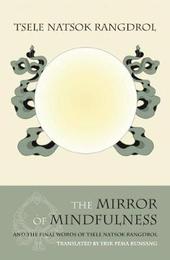
|
The Mirror of Mindfulness: The Cycle of the Four Bardos
Paperback
Main Details
| Title |
The Mirror of Mindfulness: The Cycle of the Four Bardos
|
| Authors and Contributors |
By (author) Tsele Natsok Rangdrol
|
|
Translated by Erik Pema Kunsang
|
| Physical Properties |
| Format:Paperback | | Pages:160 | | Dimensions(mm): Height 216,Width 140 |
|
| Category/Genre | Tibetan Buddhism |
|---|
| ISBN/Barcode |
9789627341659
|
| Classifications | Dewey:294.3423 |
|---|
| Audience | |
|---|
| Edition |
3rd Revised edition
|
|
Publishing Details |
| Publisher |
Rangjung Yeshe Publications,Nepal
|
| Imprint |
Rangjung Yeshe Publications,Nepal
|
| Publication Date |
13 April 2011 |
| Publication Country |
Hong Kong
|
Description
This book main idea is that intrinsic to the heart, mind and spirit in every human being is an identical essence which can be realized. This realization makes any man or woman a Buddha. The focus of this book is the method of how to implement that through a system of training which is of timeless value, and not bound by cultural limitations. The timeless truth it conveys is as meaningful for a Westerner today as it was in India and Tibet. During the centuries this system of effortless training has been applied by people from all any occupation -- tailers and kings, monks and business men -- and provided them with a simple method to not only withstand the changes of life but also to transcend them. Like the waves on an ocean, the ups and downs, joys and sorrows, we meet in our lives can be seen as movements in the ocean, giving true peace and room for caring for others. I will be hard to find another book which is as concise as Heart Lamp. The audience is the steadily increasing followers of Buddhism in the Americas, Europe and Asia, which is grown in the wake of Tibetan masters' teaching outside of Tibet. Heart Lamp is unique in that its translator worked closely with several of the most respected meditation masters of recent times and was able to receive knowledge from the "lifeblood" of the living tradition. Heart Lamp is unique in its brevity without losing the depth of a true spiritual lineage the training in which can bring about enlightenment in a single lifetime. And, it is being used as the textbook during meditation retreats around.
Author Biography
Tsele Natsok Rangdrol (born c. 1608) is renowned in the Kagyu and Nyingma schools of Tibetan Buddhism for his brilliant scholarship and meditative accomplishment. Erik Pema Kunsang Schmidt has translated and edited more than fifty volumes of Tibetan texts and oral teachings, including "Treasures from Juniper Ridge." He lives in Denmark.
Reviews"I considered that this explanation of the bardos would benefit everyone interested in the Dharma. The words are clear and easy to understand, and lengthy scholarly expositions are not emphasized. This text, easy to comprehend and containing all the key points and very direct instructions, results from following the oral advice of a qualified master."--Dilgo Khyentse Rinpoche."Bardo teachings may sound very fascinating and colourful, but the vital point is ones individual practice right now. Why have medicine when sick, if one doesnt use it? Without training, our studies become mere intellectual understanding. If study were sufficient, we could simply lean back and read a book about Dzogchen. In fact, there is no way around actual training. The whole reason for receiving bardo teachings has been traditionally described as that of "connecting a broken water pipe"--by training now, one will be able to continue the "flow" of practice through the bardo state to the following life. In the Dzogchen system bardo training is indispensable."--Tulku Urgyen Rinpoche."[T]he subject matter, death and rebirth, is a very important and pertinent topic for both Buddhists and non-Buddhists. Tibetan Buddhism contains many books which encompass teachings on that topic, and this text is ... easy to undersand. The author's style is very clear, precise, and direct.... Therefore, please read it carefully and take the meaning to heart."--Tulku Chokyi Nyima
|